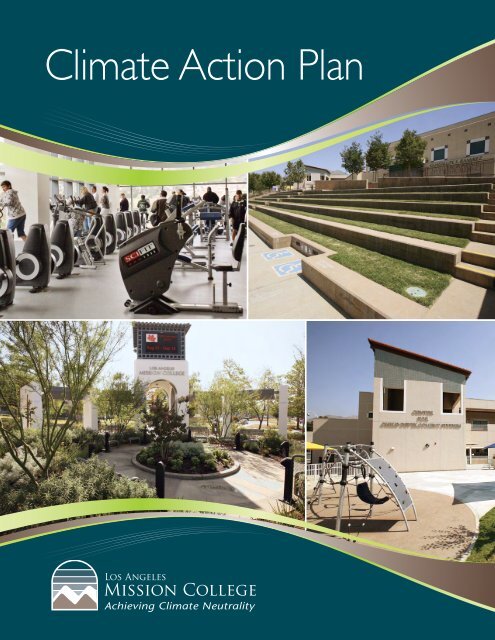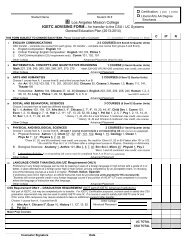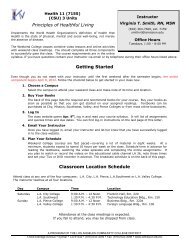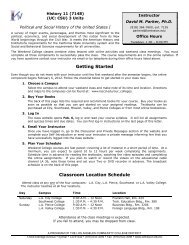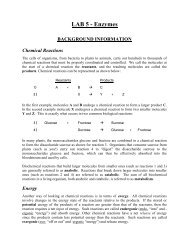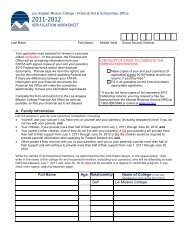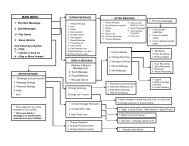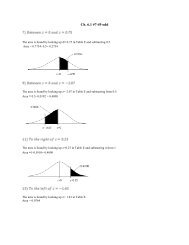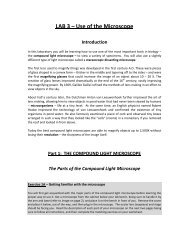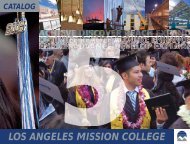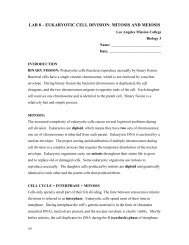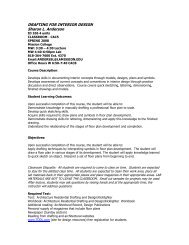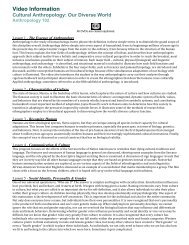Download PDF Version - Los Angeles Mission College
Download PDF Version - Los Angeles Mission College
Download PDF Version - Los Angeles Mission College
You also want an ePaper? Increase the reach of your titles
YUMPU automatically turns print PDFs into web optimized ePapers that Google loves.
Climate Action Plan
Acknowledgements<br />
LOS ANGELES COMMUNITY COLLEGE DISTRICT<br />
BOARD OF TRUSTEES<br />
Georgia L. Mercer, President<br />
Miguel Santiago, First Vice President<br />
Nancy Pearlman, Second Vice President<br />
Kelly Candaele<br />
Mona Field<br />
Tina Park<br />
Sylvia Scott-Hayes<br />
Linda L. Tong, Student Trustee<br />
Chancellor<br />
Daniel LaVista, Ph.D.<br />
LOS ANGELES MISSION COLLEGE<br />
President<br />
Judith Valles
Contents<br />
LETTER FROM THE PRESIDENT . . . . . . . . . . . . . . . . . . . . . . . . . . . . . . . . . . . . . .2<br />
Introduction . . . . . . . . . . . . . . . . . . . . . . . . . . . . . . . . . . . . . . . . . . . . . . . . . . . . . . .3<br />
Climate Change Affects the World, Our Nation, and Our<br />
Communities… and, We Effect Climate Change . . . . . . . . . . . . . . . . . . . . . . . . . .5<br />
New Lessons in Higher Education . . . . . . . . . . . . . . . . . . . . . . . . . . . . . . . . .6<br />
<strong>Los</strong> <strong>Angeles</strong> Community <strong>College</strong> District . . . . . . . . . . . . . . . . . . . . . . . . . . .7<br />
Doing Our Part at <strong>Mission</strong> <strong>College</strong> . . . . . . . . . . . . . . . . . . . . . . . . . . . . . . . .9<br />
Our Course for a Climate Action Plan . . . . . . . . . . . . . . . . . . . . . . . . . . . .10<br />
Building a Baseline Greenhouse Gas Inventory . . . . . . . . . . . . . . . . . . . . . . . . . .12<br />
Emissions Forecast and Achieving Climate Neutrality . . . . . . . . . . . . . . . . . . . . .16<br />
Climate Action Strategies . . . . . . . . . . . . . . . . . . . . . . . . . . . . . . . . . . . . . . . . . . .18<br />
Buildings . . . . . . . . . . . . . . . . . . . . . . . . . . . . . . . . . . . . . . . . . . . . . . . . . . . .18<br />
Renewable Energy . . . . . . . . . . . . . . . . . . . . . . . . . . . . . . . . . . . . . . . . . . . . .23<br />
Transportation . . . . . . . . . . . . . . . . . . . . . . . . . . . . . . . . . . . . . . . . . . . . . . .24<br />
Operations . . . . . . . . . . . . . . . . . . . . . . . . . . . . . . . . . . . . . . . . . . . . . . . . . .26<br />
Education, Community Outreach, and Research . . . . . . . . . . . . . . . . . . . . .26<br />
Monitoring and Tracking Progress . . . . . . . . . . . . . . . . . . . . . . . . . . . . . . . . . . . . .28<br />
Work with Us on Our Climate Action Plan . . . . . . . . . . . . . . . . . . . . . . . . . . . . .28<br />
i
LETTER FROM THE PRESIDENT<br />
Dear friends of <strong>Los</strong> <strong>Angeles</strong> <strong>Mission</strong> <strong>College</strong>,<br />
Over the past decade, <strong>Los</strong> <strong>Angeles</strong> <strong>Mission</strong><br />
<strong>College</strong> has taken important steps to be a<br />
more sustainable institution. We have adopted<br />
sustainable building practices in which all new<br />
buildings will be certified green buildings.<br />
We have implemented measures to reduce<br />
our water and energy use, and the amount<br />
of waste that we send to landfills. We offer<br />
programs to encourage use of our public<br />
transportation system. We have also begun<br />
collecting and reporting our annual greenhouse<br />
gas emissions to help understand<br />
our environmental footprint better. Now, our focus is on achieving aggressive<br />
greenhouse gas reduction goals.<br />
Climate change is a significant challenge that we face, and we must act now to<br />
avoid the most life-altering effects. In 2007, to strengthen our commitment to<br />
sustainability, <strong>Los</strong> <strong>Angeles</strong> <strong>Mission</strong> <strong>College</strong> signed the American <strong>College</strong> and<br />
University President’s Climate Commitment, and joined hundreds of other<br />
colleges and universities across the country that have committed to becoming<br />
a climate-neutral campus.<br />
<strong>College</strong>s may not be large greenhouse gas emitters on the global scale, but our<br />
influence is large, and it is important that we provide a good example not only<br />
for our students, but also for our community. <strong>Mission</strong> <strong>College</strong> educates more<br />
than 9,000 students every year from our local community and that number is<br />
expected to grow. We have the opportunity to transform lives, and we recognize<br />
that sustainability must be part of that transformation.<br />
<strong>Mission</strong> <strong>College</strong> has taken the bold step of developing and putting into action a<br />
plan that will help us reduce our greenhouse gas emissions. Now, we are pleased<br />
to present our climate action plan here. Through continued collaboration on implementing<br />
our climate action plan, we can achieve our goals of climate neutrality.<br />
Judith Valles<br />
President, <strong>Mission</strong> <strong>College</strong><br />
2
INTRODUCTION<br />
<strong>Los</strong> <strong>Angeles</strong> <strong>Mission</strong> <strong>College</strong> is on a quest to become climate neutral by 2050<br />
We’re serious about this quest: we made an official commitment to it by agreeing<br />
to the American <strong>College</strong> and University President’s Climate Commitment in 2007.<br />
How do we get there?<br />
<strong>Los</strong> <strong>Angeles</strong> <strong>Mission</strong> <strong>College</strong> (<strong>Mission</strong> <strong>College</strong>) has taken the initial steps. We have<br />
developed our baseline greenhouse gas inventory, determined our strategies, and<br />
begun to implement measures. Now, our climate action plan will guide us toward<br />
achieving greenhouse gas emission reductions and climate neutrality. This critical<br />
tool is a roadmap into our future. It will help us monitor progress, measure outcomes,<br />
and be accountable.<br />
Our climate action plan outlines strategies and milestones to lead <strong>Mission</strong> <strong>College</strong><br />
students, faculty, and staff through the next 40 years. This is a crucial time period<br />
during which our actions, along with those of institutions, businesses, and governments<br />
around the world, will largely determine the world’s fate with global warming.<br />
As our climate action plan progresses, we have many responsibilities:<br />
■ We have to dedicate our efforts to short-, medium-, and long-term tasks.<br />
■<br />
■<br />
■<br />
■<br />
We have to learn new thought processes, knowledge fields, techniques, and<br />
cutting-edge technologies to apply new processes and introduce new solutions.<br />
We also have to embrace lessons from unintended or unexpected results.<br />
We have to be resourceful and collaborative. We have to acquire skills and<br />
knowledge from institutions experienced in certain project areas, and we<br />
have to share best practices and experiences with institutions tackling new<br />
challenges, in which we have gained insights.<br />
We have to be adaptable to changes for a better future, be patient<br />
through processes, and be flexible in adjusting our course when called<br />
for by external factors.<br />
We have to recognize the small wins and the major accomplishments.<br />
Most importantly, for our climate action plan to succeed, we must ensure<br />
two conditions are consistently met:<br />
■ Everyone at <strong>Mission</strong> <strong>College</strong> must be involved: students, faculty, administrators,<br />
and staff. We hope everyone will be actively engaged as we execute<br />
our plan and work together towards an environmentally and economically<br />
sustainable future for all.<br />
■<br />
Climate action plan strategies and tactics must align with our vision:<br />
to be an exemplary model for student academic, technological and<br />
artistic achievement.<br />
3
CLIMATE CHANGE<br />
IMPACTS OUR<br />
WORLD, OUR<br />
NATION AND<br />
OUR COMMUNITY
Climate Change Affects the World, Our<br />
Nation, and Our Communities…and,<br />
We Effect Climate Change<br />
Climate change presents one of the most<br />
profound challenges of our time. A broad<br />
international consensus exists among atmospheric<br />
scientists that Earth’s climate system<br />
is changing in response to elevated levels of<br />
greenhouse gas emissions in the atmosphere<br />
primarily from the combustion of fossil fuels<br />
for energy use.<br />
Global Climate Change Impacts in the<br />
United States 1 —a few key findings:<br />
1. Global warming is unequivocal and<br />
primarily human-induced.<br />
Average global temperature has increased<br />
over the past 50 years. This observed increase<br />
is primarily due to human-induced<br />
emissions of heat-trapping gases.<br />
2. Climate changes are underway in the<br />
United States and are projected to grow.<br />
Climate-related changes have already<br />
been observed in the United States and its<br />
coastal waters. These include increases in<br />
heavy downpours, rising temperature<br />
and sea level, rapidly retreating glaciers,<br />
thawing permafrost, lengthening growing<br />
seasons, lengthening ice-free seasons in<br />
the ocean and on lakes and rivers, earlier<br />
snowmelt, and alterations in river flows.<br />
These changes are projected to grow.<br />
3. Widespread climate-related impacts<br />
are now occurring and are expected<br />
to increase.<br />
Climate change is already affecting water,<br />
energy, transportation, agriculture, ecosystems,<br />
and health. These impacts are<br />
different from region to region and will<br />
grow under projected climate change<br />
scenarios.<br />
4. Future climate change and its impacts<br />
depend on choices made today.<br />
The amount and rate of future climate<br />
change depend primarily on current and<br />
future human-caused emissions of heattrapping<br />
gases and airborne particles.<br />
Responses involve reducing emissions<br />
to limit future warming, and adapting<br />
to the changes that are unavoidable.<br />
We need to reduce greenhouse<br />
gas emissions: 2,3<br />
■<br />
■<br />
■<br />
Over the next century, limiting the increase<br />
in average global temperature to 2°C<br />
may avoid the most damaging and<br />
irreversible impacts of global warming.<br />
Greenhouse gas emissions need to be<br />
stabilized well below 450 parts per million<br />
to minimize the average global temperature<br />
increase to 2°C.<br />
Global greenhouse gas emissions must<br />
be reduced by at least 50% of their<br />
1990 levels by the year 2050, in order to<br />
reduce the risks of severe climate change.<br />
1. U.S. Global Change Research Program (USGCRP) 2009. “Global Climate Change Impacts in the United States.” Page 12.<br />
http://www.globalchange.gov/publications/reports/scientific-assessments/us-impacts This report was issued in 2009, by a task force of<br />
U.S. government science agencies led by the National Oceanic and Atmospheric Administration (NOAA).<br />
2. International Climate Change Task force. “Meeting the Challenge of Climate Change.” 2005. http://www.americanprogress.org/kf/climatechallenge.pdf<br />
3. University of New South Wales Climate Change Research Centre. http://www.ccrc.unsw.edu.au/news/2007/Bali.html 2007 Bali Declaration by Scientists.<br />
5
New Lessons in Higher Education<br />
We have all contributed to the progression<br />
of climate change, and we all have a role<br />
in changing its course.<br />
<strong>College</strong>s and universities have a pivotal role<br />
in advancing sustainable business practices,<br />
since we have a great influence on our next<br />
generation of young professionals. We have<br />
a responsibility to lead our students on the<br />
right course, through learning opportunities<br />
that empower them to understand climate<br />
change, make decisions for sustainable<br />
living, and use new skills to build a safer<br />
and healthier future.<br />
Higher education is a billion dollar economic<br />
engine: We employ millions of people;<br />
consume vast resources, manufactured<br />
goods, and services; and cater to more than<br />
17 million students who are attending the<br />
more than 4,000 higher learning institutions<br />
in the United States. 4 Students will pursue<br />
many different careers, and they will have<br />
an impact on businesses, organizations, and<br />
operations of all types. They need to acquire<br />
knowledge and skills in new disciplines to<br />
effect positive change.<br />
Higher education is in the best position<br />
to not only teach our next generations<br />
the critical lessons and tools to create<br />
a new course for our future, but also to<br />
take actions as an institution to model<br />
ways that can help foster improved<br />
climate conditions.<br />
The American <strong>College</strong> & University Presidents’ Climate Commitment (ACUPCC)<br />
is a growing network of colleges and universities that have committed to develop<br />
and implement plans in pursuit of climate neutrality. 5<br />
Higher education has been granted tax-free status, the ability to receive public and<br />
private funds, and academic freedom, in exchange for educating students and producing<br />
the knowledge that will result in a thriving civil society. For these reasons,<br />
higher education has a moral and social responsibility to rise to this challenge. 6<br />
American <strong>College</strong> & University Presidents’ Climate Commitment.<br />
4. ACUPCC Website “Why Sign the Commitment” http://www.presidentsclimatecommitment.org/about/commitment/why-sign<br />
5. ACUPCC Website “<strong>Mission</strong> and History” http://www.presidentsclimatecommitment.org/about/mission-history<br />
6. ACUPCC Website “Why Sign the Commitment” http://www.presidentsclimatecommitment.org/about/commitment/why-sign<br />
6
<strong>Los</strong> <strong>Angeles</strong> Community <strong>College</strong> District<br />
The <strong>Los</strong> <strong>Angeles</strong> Community <strong>College</strong> District<br />
(LACCD) is the largest community college<br />
district in the United States. It has nine<br />
colleges, including <strong>Mission</strong> <strong>College</strong>, and it<br />
covers an area greater than 882 square miles<br />
in more than 36 cities and communities.<br />
LACCD offers lifelong learning opportunities<br />
for students.<br />
As a higher education institutional system,<br />
LACCD recognized its responsibility to reduce<br />
greenhouse gas emissions. Former LACCD<br />
Chancellor Darroch Young and the current<br />
Chancellor Daniel LaVista also understood<br />
the urgency to take action. The District became<br />
one of the 12 founding signatories of<br />
the American <strong>College</strong> & University Presidents’<br />
Climate Commitment (ACUPCC) in 2006.<br />
LACCD has been a rising leader in advancing<br />
sustainable practices. Its hallmark initiative is<br />
the $6 billion Sustainable Building Program<br />
to replace buildings in states of disrepair<br />
and neglect.<br />
LACCD Firsts:<br />
■<br />
■<br />
■<br />
■<br />
■<br />
First community college system to require LEED certification for new buildings<br />
First community college system to achieve a BREEAM (BRE Environmental<br />
Assessment Method) certification<br />
First community college system to sign on to the ACUPCC Climate Commitment<br />
First community college system to host the UC/CSU/CCC Annual Sustainability<br />
Conference<br />
First community college system to join the California Climate Action Registry<br />
7
LACCD Awards and Recognitions<br />
2010<br />
IIDA Caliber Environmental Leadership Award for commitment to sustainability and<br />
influence on the broader community (International Interior Design Association)<br />
2009<br />
Sustainability Showcase Award, Other Products and Services category (California<br />
Sustainability Alliance)<br />
Community Impact Award (<strong>Los</strong> <strong>Angeles</strong> Business Council)<br />
Higher Education Energy Efficiency Best Practices award (UC/CSU/CCC Sustainability<br />
Conference)<br />
Green California Leadership Award (Green Technology and Advisory Board for the<br />
Green Calif. Summit)<br />
Sustainable Leadership and Design Development Non-Profit award (CoreNet Global)<br />
Leonardo Public Sector Industry Honor Award (Society for Marketing Professional<br />
Services, <strong>Los</strong> <strong>Angeles</strong> Chapter)<br />
2008<br />
Green Leadership Achievement Award (Green California Community <strong>College</strong> Summit)<br />
REmmy Corporate Citizens Award (CoreNet Global)<br />
Energy Efficiency Partnership Program Best Practices in New Construction &<br />
Sustainable Operations (UC/CSU/CCC Sustainability Conference)<br />
2007<br />
Clinton Climate Initiative<br />
Governor's Environmental and Economic Leadership Award - Sustainable Practices<br />
or Facilities<br />
California Construction Owner of the Year - McGraw Hill (California Construction<br />
Magazine)<br />
2006<br />
Savings by Design Award (Southern California Gas Company)<br />
Sustainable Future Award (U.S. Green Building Council - <strong>Los</strong> <strong>Angeles</strong> Chapter)<br />
Flex Your Power (State of California)<br />
2005<br />
Flex Your Power Education and Leadership (State of California)<br />
Visionary Leadership Award (U.S. Green Building Council - <strong>Los</strong> <strong>Angeles</strong> Chapter)<br />
Sempra Energy Efficiency Excellence Award<br />
2004<br />
California/Local Environmental Leadership Award (Global Green U.S.A.<br />
Millennium Awards)<br />
Visionary Award (U.S. Green Building Council)<br />
Flex Your Power Award (State of California)<br />
8
Doing Our Part at <strong>Mission</strong> <strong>College</strong><br />
Founded in 1975, <strong>Mission</strong> <strong>College</strong> is the<br />
youngest of the nine colleges in the <strong>Los</strong><br />
<strong>Angeles</strong> Community <strong>College</strong> District. We<br />
offer accessible, affordable and high quality<br />
education in a culturally and intellectually<br />
supportive environment across our 32 acre<br />
campus in Sylmar, California.<br />
Our campus is undergoing a<br />
transformation.<br />
Student enrollment is expected to continue<br />
to increase through 2015 to near 15,000<br />
students from our current 11,500 students.<br />
To accommodate this growth we will be<br />
expanding to a total of 555,000 square feet<br />
of instructional and support facilities on the<br />
Main Campus and our new East Campus.<br />
We are dedicated to<br />
creating a more<br />
sustainable future.<br />
1<br />
3<br />
4<br />
2<br />
9<br />
HUBBARD STREET<br />
5 6 7 8<br />
bk<br />
bl<br />
bm<br />
MAIN CAMPUS<br />
1 CHILD DEVELOPMENT CENTER<br />
2 COLLABORATIVE STUDIES<br />
3 CAMPUS SERVICES<br />
4 FAMILY & CONSUMER STUDIES/BOOKSTORE<br />
ELDRIDGE AVENUE<br />
5 LEARNING RESOURCE CENTER/LIBRARY<br />
6 MAIN QUAD<br />
7 CAMPUS CENTER<br />
8 MEDIA ARTS<br />
9 PLANT FACILITIES & CENTRAL PLANT<br />
bk PARKING STRUCTURE<br />
bl INSTRUCTIONAL ADMINISTRATION<br />
bm STUDENT SERVICES & ADMINISTRATION<br />
MACLAY STREET<br />
br<br />
bq<br />
bn<br />
bo<br />
bp<br />
HARDING STREET<br />
EAST CAMPUS<br />
bn PROPOSED NCAA SOCCER FIELD<br />
bo PROPOSED NCAA SOFTBALL FIELD<br />
bp PROPOSED NCAA BASEBALL FIELD<br />
bq HEALTH FITNESS & ATHLETIC COMPLEX<br />
br EAST CAMPUS BUILDING<br />
9
Our Course for a Climate Action Plan<br />
From our buildings and curriculum to our administration and operations, we are making<br />
physical, environmental, and social changes to improve <strong>Mission</strong> <strong>College</strong> to meet the needs<br />
of our students.<br />
Cultivating campus sustainability is a cornerstone of the <strong>Mission</strong> <strong>College</strong> climate<br />
action plan.<br />
As a signatory of the American <strong>College</strong> & University Presidents’ Climate Commitment,<br />
<strong>Mission</strong> <strong>College</strong> agreed to:<br />
■<br />
■<br />
■<br />
■<br />
■<br />
Complete a greenhouse gas emissions inventory<br />
Set a target date for becoming climate neutral<br />
Take immediate steps to reduce greenhouse gas emissions<br />
Integrate sustainability into the curriculum and make it part of the educational<br />
experience<br />
Develop a climate action plan that outlines strategies and tactics to achieve<br />
climate neutrality<br />
Here, in our climate action plan, we highlight strategies and tactics that will enable us to<br />
minimize greenhouse gas emissions and meet our social mandate to help create a thriving,<br />
ethical and sustainable society.<br />
10
ESTABLISHING<br />
A BASELINE
Building a Baseline Greenhouse<br />
Gas Inventory<br />
In 2005, as part of an LACCD district-wide<br />
initiative, <strong>Mission</strong> <strong>College</strong> joined the California<br />
Climate Action Registry (CCAR). That year,<br />
LACCD conducted a greenhouse gas (GHG)<br />
emissions inventory of the 2004 calendar<br />
year to establish a baseline for each of its<br />
nine campuses and the District Office. LACCD<br />
has conducted subsequent inventories for<br />
2005 through 2009.<br />
<strong>Mission</strong> <strong>College</strong>’s greenhouse gas inventory<br />
accounts for emissions in three categories:<br />
■<br />
■<br />
■<br />
Consumption of natural gas in campus<br />
buildings and other onsite combustibles,<br />
such as gasoline-driven lawn mowers<br />
and diesel back-up generators<br />
Electricity consumption in campus<br />
buildings<br />
Gasoline and diesel fuel consumption for<br />
student, faculty and staff commuting<br />
The Kyoto Protocol is a protocol<br />
to the United Nations Framework<br />
Convention on Climate Change<br />
(UNFCCC). The agreement identifies<br />
six high priority greenhouse gases<br />
for reductions:<br />
■<br />
■<br />
■<br />
■<br />
■<br />
■<br />
Carbon dioxide (CO2)<br />
Methane (CH4)<br />
Nitrous Oxide (N2O)<br />
Hydroflourocarbons (HFCs)<br />
Perflourocarbons (PFCs)<br />
Sulfur hexafluoride (SF6)<br />
Climate Leader Recognized by California Climate Action Registry (CCAR)<br />
<strong>Mission</strong> <strong>College</strong> follows the CCAR General Reporting Protocol<br />
to collect, calculate, and report GHG emissions data.<br />
<strong>Mission</strong> <strong>College</strong>’s 2007, 2008 and 2009 inventories have<br />
been adjusted to include all six greenhouse gases.<br />
A third party verifies all of <strong>Mission</strong> <strong>College</strong>’s data collected.<br />
<strong>Mission</strong> <strong>College</strong>’s annual emission reports are available to the public on the California<br />
Climate Action Registry (CCAR) website, www.climateregistry.org/.<br />
12
Since we began measuring and monitoring<br />
our GHG emissions, <strong>Mission</strong> <strong>College</strong> has<br />
undergone numerous facility changes, which<br />
include a new parking structure; the new<br />
Bio Lab; new Health, Fitness, and Athletic<br />
Complex; and the nearly completed Family<br />
and Consumer Studies Building. The new<br />
facilities will better serve our students. With<br />
this growth however, comes an increase in<br />
campus emissions.<br />
■<br />
■<br />
■<br />
The largest increase in emissions comes<br />
from electricity use in buildings.<br />
Emissions from natural gas used for<br />
boilers and kitchen equipment have<br />
remained relatively constant.<br />
Emissions from commuting and air travel<br />
have also remained relatively stable, but<br />
are estimated to rise as the student population<br />
is projected to increase.<br />
13
Building Electricity<br />
<strong>Mission</strong> <strong>College</strong> campus buildings typically<br />
use electricity for lighting, motors, fans,<br />
heating and cooling systems, and plug loads,<br />
such as computers. We purchase electricity<br />
from the <strong>Los</strong> <strong>Angeles</strong> Department of Water<br />
and Power.<br />
We purchased 5,349 megawatt-hours<br />
(MWh) of electricity from <strong>Los</strong> <strong>Angeles</strong><br />
Department of Water and Power in<br />
2008, equivalent to 2,984 MTCO2e.<br />
Transportation Fuels<br />
Commuting is part of everyday life at a<br />
community college, for faculty, staff, and<br />
students, alike. In 2008, <strong>Mission</strong> <strong>College</strong><br />
student, staff, and faculty commuters<br />
were responsible for approximately 2,535<br />
MTCO2e of indirect mobile (gasoline and<br />
diesel) emissions.<br />
Building Natural Gas<br />
As of 2008, the main sources of natural<br />
gas consumption are boilers and kitchen<br />
equipment. 7 The Southern California Gas<br />
Company supplies this natural gas.<br />
We purchased 82,548 therms of natural<br />
gas from Southern California Gas<br />
Company, equivalent to 439 MTCO2e.<br />
What is a metric ton of carbon dioxide equivalent (MTCO2e)?<br />
Each of the six Kyoto greenhouse gases has different global warming potentials, meaning<br />
they have differing abilities to trap heat in the atmosphere. The total emissions of all six<br />
greenhouse gases are normalized according to their global warming equivalence to a<br />
molecule of carbon dioxide (CO2e). And a metric ton is approximately 2204 pounds!<br />
7. <strong>Los</strong> <strong>Angeles</strong> Community <strong>College</strong> District, Greenhouse Gas Emissions Inventory Verification Report, 2008, Appendix D<br />
14
ACHIEVING<br />
CLIMATE<br />
NEUTRALITY
Emissions Forecast and Achieving<br />
Climate Neutrality<br />
Global greenhouse gas emissions must be<br />
reduced 50-80% by 2050 to avoid dramatic<br />
consequences of climate change. 8<br />
California has committed to reduce<br />
GHG emissions by 80% of its 1990<br />
levels, by 2050. 9<br />
<strong>Mission</strong> <strong>College</strong> will go beyond the recommended<br />
reduction goal for GHG emissions<br />
to achieve climate neutrality by 2050.<br />
A climate action plan must state an emissions<br />
forecast. This forecast helps foster a concerted<br />
effort to implement emission reduction<br />
projects, and it establishes a comparative<br />
measure between future emission reductions<br />
and business-as-usual (BAU) emission levels<br />
to track progress.<br />
The business-as-usual emissions forecast for<br />
<strong>Mission</strong> <strong>College</strong> is based on several factors:<br />
■<br />
The emissions trend calculated from<br />
2004 through 2009<br />
■<br />
■<br />
The new construction projects planned<br />
through 2015<br />
A projected trend line for <strong>Mission</strong><br />
<strong>College</strong>’s emissions from continued<br />
expansion on our Main Campus, East<br />
Campus and Athletic Fields Complex<br />
In this climate action plan, we share how we<br />
will move away from the business-as-usual<br />
scenario and achieve climate neutrality.<br />
What is Climate Neutrality?<br />
According to the ACUPCC, climate<br />
neutrality is defined as having no net<br />
greenhouse gas emissions.<br />
Climate neutrality can be achieved by<br />
minimizing GHG emissions as much as<br />
possible, prior to considering carbon<br />
offsets or other offsite mitigation<br />
measures.<br />
16<br />
8. Intergovernmental Panel on Climate Change – Fourth Assessment Report (2007).<br />
9. Executive Order S-3-05, signed by Governor Schwarzenegger in 2005
IMPROVING<br />
CAMPUS<br />
LIFE
Climate Action Strategies<br />
<strong>Mission</strong> <strong>College</strong>’s climate action strategies target the largest sources of greenhouse<br />
gas emissions: buildings and transportation.<br />
Buildings<br />
DISTRICT-WIDE SUSTAINABLE BUILDING PROGRAM<br />
In 2002, the <strong>Los</strong> <strong>Angeles</strong> Community <strong>College</strong> District Board of Trustees adopted<br />
a groundbreaking commitment to sustainability — a sustainable policy mandate<br />
that requires a LEED-certified rating or better for all new construction and major<br />
renovation projects throughout its college campuses. Today, the LACCD is at<br />
the helm of a $6 billion Sustainable Building Program, which is among the<br />
nation’s largest environmentally friendly green-building programs.<br />
The Sustainable Building Program cultivates positive impacts for society:<br />
■<br />
■<br />
■<br />
Creates improved environments that are better suited to prepare and<br />
train students for twenty-first century jobs<br />
Boosts the California economy<br />
Models sustainable practices and decreases the District’s GHG emissions<br />
To supplement the Board’s policy, a sustainable standards and specification was<br />
launched to give designers guidelines to focus their efforts on conserving energy,<br />
integrating sustainable siting design, reducing waste and water consumption,<br />
improving indoor air quality, and using sustainable materials and resources.<br />
All buildings will be designed and constructed with environmental<br />
sensitivity in mind.<br />
18
LACCD Building Measures to Reduce Greenhouse<br />
Gas Emissions and Improve Campus Sustainability<br />
Water use measures<br />
■<br />
■<br />
■<br />
■<br />
Collect all stormwater so none shall leave<br />
the campus: store collected stormwater<br />
to re-use or infiltrate onsite<br />
Reduce potable water demand for all<br />
landscaping by a minimum of 50%:<br />
utilize Xeriscaping and drought<br />
resistant planting<br />
Reuse and collect greywater<br />
Reduce potable water demand for<br />
buildings by at least 40%: install<br />
waterless urinals in all new and<br />
existing buildings<br />
Energy use measures<br />
■ Reduce the heat island effect: use cool<br />
roofs and appropriate materials, such as<br />
green roofs where applicable and less<br />
dark materials like asphalt<br />
■ Design new buildings to exceed Title 24<br />
by 20% and major renovations to exceed<br />
Title 24 by 10%<br />
■ Measure and verify energy use and analyze<br />
system trends to optimize building<br />
operations and energy performance<br />
■<br />
Conduct whole-building enhanced<br />
commissioning to ensure systems are<br />
operating as designed and maximize<br />
energy efficiency<br />
Renewable energy generation<br />
measures<br />
■<br />
■<br />
Use photoluminescent exit signage,<br />
which harnesses solar power, thereby<br />
reducing electricity demand from<br />
electric-powered exit signs<br />
Generate at least 10% of each building’s<br />
energy through renewable technologies<br />
What is Title 24?<br />
Title 24 of the California Code of<br />
Regulations, also known as the<br />
California Building Standards Code,<br />
contains the regulations that govern<br />
the energy consumption standards<br />
for buildings.<br />
19
Material reuse and recycling measures<br />
■<br />
■<br />
■<br />
Ensure 90% of materials generated from<br />
construction and demolition activities are<br />
diverted from landfills: recycle, reuse, or<br />
repurpose a minimum of 90% marketable<br />
materials. (LACCD’s goal is to divert<br />
100% of all construction and demolition<br />
waste from landfills.)<br />
Use recycled carpet that comprises<br />
100% recycled content for the backing<br />
and up to 75% recycled content for the<br />
carpet fiber.<br />
Use 35% fly ash in concrete, which<br />
contributes to recycled content use.<br />
<strong>Mission</strong> <strong>College</strong> will continue to undergo<br />
facility renovations and new construction.<br />
While new buildings contribute to a net<br />
increase in electricity and natural gas<br />
consumption, we are seeking to reduce<br />
the impact as much as possible through<br />
implementing LEED standards for new<br />
construction.<br />
<strong>Mission</strong> currently has seven LEED projects<br />
registered, with a range of targets from<br />
Certified to Platinum levels.<br />
Sustainable carpet materials: Every fiber counts<br />
LACCD’s carpet manufacturer has agreed to reduce the cost, demonstrate the ability to<br />
recycle products at the end of their useful lives, and adhere to other sustainable practices:<br />
■<br />
■<br />
■<br />
■<br />
■<br />
Use materials in which a minimum of 90% can be recycled<br />
Obtain third-party certification to verify antimicrobials have not been added<br />
to products<br />
Obtain third-party certification for the use of environmentally preferable products<br />
Use only products that comply with the U.S. Federal Trade Commission’s<br />
guidelines to environmental marketing for recycled content<br />
Offer a take-back program in place for its products, with a sustainable warranty<br />
that guarantees all carpet returned will be recycled in its entirety and no portion<br />
will be added to a landfill, incinerated (including waste-to-energy), or disposed<br />
of in any other way<br />
20
Child Development Center<br />
We built the new Child Development Center<br />
to serve as an ideal child development laboratory<br />
for students majoring in Childhood<br />
Education. Students use the facility to identify,<br />
study, and demonstrate developmentally<br />
appropriate practices for childhood development.<br />
It also offers a high quality childhood<br />
education and care program for the college<br />
community as well as the local community<br />
at-large. The facility includes classrooms,<br />
three observation rooms for parents, students<br />
and faculty, a staff room, an open office area,<br />
outdoor age-appropriate play areas, and<br />
warming kitchen for receiving and<br />
distributing meals.<br />
The facility is designed to be LEED Certified.<br />
We incorporated a variety of sustainability<br />
features in the design of the building including:<br />
■<br />
■<br />
■<br />
Building materials that are high in<br />
recycled content<br />
Drought resistant and native plants to<br />
reduce irrigation needs<br />
A roof designed to accommodate future<br />
photovoltaic cells<br />
■<br />
Extensive daylighting that creates a<br />
visually stimulating and productive<br />
environment<br />
21
Health, Fitness and Athletic Complex<br />
Completed in February 2010, our new Health,<br />
Fitness and Athletic Complex fulfilled a need<br />
that had been in existence for over 20 years.<br />
It replaced a rented warehouse one and a<br />
half miles from campus that held activities<br />
such as weight training and aerobics classes.<br />
The new athletic complex is an 89,500<br />
square-foot structure that comes with a<br />
3-court gym suitable for basketball and<br />
volleyball, as well as a fitness room,<br />
jogging track, five classrooms, a training<br />
room, locker rooms and offices.<br />
We designed the facility according to the<br />
U.S. Green Building Council’s LEED Silver<br />
rating standards. Green features include:<br />
■<br />
■<br />
■<br />
■<br />
■<br />
Locally sourced materials with high<br />
recycled content<br />
A “cool roof” to reduce cooling needs<br />
Water efficient low flow plumbing fixtures<br />
On-site thermal storage system<br />
Diversion of more than 90 percent of the<br />
construction waste from landfills<br />
Family and Consumer Studies Building<br />
Designed to achieve a LEED Platinum rating,<br />
the new Family and Consumer Studies Building<br />
will be a three-story learning facility that<br />
consists of:<br />
■<br />
■<br />
Eight lecture classrooms with distance<br />
learning capabilities<br />
State-of-the-art prepping and cooking<br />
facilities<br />
■<br />
■<br />
Specialty food service laboratories<br />
Dining presentation classroom<br />
This new facility will incorporate a variety of<br />
sustainability and energy efficiency strategies<br />
including natural lighting throughout the<br />
facility, high efficiency lighting, waterless<br />
urinals and low flow toilets, solar-cell operated<br />
faucets, drip irrigation and a highly efficient<br />
heating and ventilation system.<br />
Other <strong>Mission</strong> <strong>College</strong> projects include a new student services center, a new Media<br />
Arts Center, a new campus Sheriff’s Station, and a new plant facilities building.<br />
22
Renewable Energy<br />
<strong>Mission</strong> <strong>College</strong> is capitalizing on our<br />
location in sunny California: We have<br />
committed to photovoltaic power for<br />
onsite energy generation.<br />
Producing energy from clean renewable<br />
resources on campus helps reduce our<br />
dependency on fossil fuels and reduce<br />
greenhouse gas emissions. We constructed<br />
a 178 kW solar photovoltaic system on the<br />
rooftop of Parking Structure A in 2007.<br />
The solar farm generates enough electricity<br />
to power almost 200 homes. The array<br />
has 1,128 PV panels and covers an area of<br />
approximately 16,900 square feet. We aim<br />
to acquire 40% of our electrical energy from<br />
clean renewable sources.<br />
We will continuously evaluate the latest<br />
opportunities, technologies, and applications<br />
to promote cleaner sources of on-campus<br />
electricity generation.<br />
23
Transportation<br />
Student Commuting<br />
The <strong>Los</strong> <strong>Angeles</strong> Community <strong>College</strong> District<br />
I-TAP (Transit Access Pass) program is a key<br />
initiative to reduce transportation-related<br />
greenhouse gas emissions.<br />
During the first year of the two-year I-TAP<br />
program, full-time students can purchase a<br />
semi-annual pass, offered year-round, for<br />
uninterrupted access to transit services for<br />
attending classes within the district. During<br />
the second year of the program, LACCD<br />
offers the pass on a semester basis, which<br />
covers three semesters.<br />
Full-time students can purchase a semi-annual<br />
pass for $15, which is a 93% discount from<br />
the regular price, or a semester pass for<br />
$15, which equals a discount of 89%.<br />
For the 2009 spring and fall semesters, a<br />
total of 6 million transit trips on Metro<br />
services were clocked using I-TAP. At an<br />
average of 7 miles on each trip, that<br />
represents a reduction of 42 million VMT<br />
(vehicles miles traveled) and 36 tons of CO2.<br />
I-TAP Program Benefits:<br />
■ Provides a low-cost, sustainable<br />
transportation option for students,<br />
particularly those taking courses on<br />
multiple campuses<br />
■<br />
■<br />
■<br />
■<br />
Addresses the daily transportation needs<br />
of students in regard to education, job<br />
training, and employment<br />
Reduces VMT significantly, in a region<br />
that is challenged by poor air quality and<br />
traffic congestion<br />
Supports LACCD’s commitment to<br />
sustainability and climate neutrality<br />
Reduces demand for on-campus parking<br />
and therefore, impervious surfaces<br />
This program is funded through Measure J to<br />
address the interruption of on-campus parking<br />
during construction phases at LACCD campuses.<br />
Photo courtesy of: Metro <strong>Los</strong> <strong>Angeles</strong>/gary leonard<br />
Staff and Faculty Commuting<br />
<strong>Mission</strong> <strong>College</strong> offers assistance to employees<br />
who choose alternative methods of commuting<br />
to campus. For instance, employees<br />
who carpool are eligible to parking in the<br />
designated carpool parking areas and may<br />
receive a monthly cash subsidy. Other<br />
programs include:<br />
■<br />
■<br />
■<br />
■<br />
Transit Subsidies. Employees who take<br />
the bus or Metro link train to work<br />
receive $2.00 a day up to $40.00 per<br />
month cash subsidy.<br />
Compressed Work Week. Employees<br />
whose work area is not affected have the<br />
option to work their 40-hour-work weeks<br />
in four days instead of five (10 hours per<br />
day), or complete 80 hours within a twoweek<br />
period in nine days instead of ten<br />
with supervisory approval.<br />
Guaranteed Ride Home. Employees who<br />
carpool and have an unexpected reason<br />
to leave work early or late will be given a<br />
ride home.<br />
Flexible Hours. Employees who carpool,<br />
take the bus or train, bicycle or walk are<br />
able to adjust their regular 8-hour daily<br />
schedule to come to work earlier or later<br />
with supervisory approval.<br />
24
■<br />
■<br />
■<br />
Bicycle parking. We provide bicycle racks<br />
for secure storage of bicycles and participants<br />
receive a monthly cash subsidy.<br />
Personalized Commute Assistance.<br />
Our Employee Transportation Coordinator<br />
(ETC) personally assists employees with<br />
alternative commute options, such as<br />
finding someone to ride with, or obtaining<br />
bus schedules.<br />
Start-Up Incentive. We provide a<br />
$10.00 start-up incentive to employees<br />
who commit to an alternative mode of<br />
transportation for 10 working days.<br />
Business Travel<br />
<strong>Mission</strong> is equipped with video-conferencing<br />
facilities to reduce greenhouse gas emissions<br />
related to business travel. Video conferencing<br />
allows representatives from all LACCD campuses<br />
to participate face-to-face in required<br />
and functional meetings. It has also increased<br />
our productivity, while significantly reducing<br />
GHG emissions from travelling.<br />
Campus Fleet Vehicles<br />
Electric vehicles have the potential to<br />
significantly reduce greenhouse gas<br />
emissions compared to conventional<br />
gasoline- and diesel-powered vehicles,<br />
according to a recent study by the Electric<br />
Power Research Institute and the Natural<br />
Resources Defense Council.<br />
Our campus vehicle fleet is in the process of<br />
being phased into an electric vehicle fleet.<br />
As our vehicles’ life cycles end and other<br />
opportunities arise, we are replacing these<br />
older vehicles with electric vehicles, so <strong>Mission</strong><br />
<strong>College</strong> will have a vast electric vehicle fleet<br />
inventory in the next decade.<br />
State-of-the-Art Communication Technology<br />
LACCD needed a video solution that served as a clean, efficient way to communicate,<br />
since executive groups and project management teams are dispersed across 882<br />
square miles. LACCD installed 23 high definition video-conference systems among<br />
nine campuses.<br />
Operations<br />
The <strong>Los</strong> <strong>Angeles</strong> Community <strong>College</strong> District<br />
has an innovative recycling program in place,<br />
which reduces GHG emissions from waste<br />
going to landfills. <strong>Mission</strong> <strong>College</strong> annually<br />
diverts an average of 43 tons of waste from<br />
landfills via recycling.<br />
continue to compost grass, but on-campus<br />
construction has lessened this need for<br />
<strong>Mission</strong> <strong>College</strong>. In 2009, Build LACCD introduced<br />
a program for all campuses to receive<br />
compacting trash units and for all campuses<br />
to use green equipment and materials.<br />
We have a material reuse program for furniture,<br />
equipment, computers, and books. We also<br />
25
Education, Community Outreach and Research<br />
As a comprehensive community college,<br />
<strong>Mission</strong> <strong>College</strong> serves the educational needs<br />
of our neighbors throughout the greater<br />
San Fernando Valley. We offer programs,<br />
resources, and support, so our students can<br />
develop the knowledge and skills necessary<br />
for optimal growth and achievement.<br />
Through our curriculum, we are seeking<br />
to permanently institutionalize our passion<br />
and commitment for sustainability.<br />
<strong>Mission</strong> <strong>College</strong>’s Educational Planning<br />
Committee has identified Applied and<br />
Environmental Technologies as a target<br />
for program development to address the<br />
needs of the growing green economy.<br />
While developing a number of new courses,<br />
we are also working to infuse sustainability<br />
into a number of existing courses. Many of<br />
our courses are also offered online to provide<br />
students the flexibility they need to manage<br />
their personal lives and also reduce the<br />
amount of time they spent sitting in traffic.<br />
Our curriculum will enable students to build<br />
awareness of LACCD’s energy efficiency<br />
initiatives, encourage behavioral and operational<br />
changes to maximize new building<br />
efficiency, assist with energy-saving retrofits,<br />
and participate in hands-on projects to<br />
augment classroom study. Additionally, we<br />
will prepare students for green employment<br />
opportunities by helping them build relevant<br />
job skills and linking them with employers.<br />
We will continue to partner with key stakeholders<br />
to engage the campus community in<br />
energy- and money-saving activities—many<br />
of which mirror the District’s current energy<br />
efficiency initiatives.<br />
Green Technology Programs<br />
The District’s colleges are committed<br />
to developing sustainable components<br />
in existing programs, creating new<br />
programs, and redesigning curriculum<br />
to infuse sustainability into all courses<br />
and programs.<br />
These Green Technology Programs are<br />
a work in progress. They are a portrait<br />
of the present, as well as a window into<br />
the future of sustainable education at<br />
the colleges.<br />
26
THE FUTURE OF<br />
SUSTAINABILITY
Monitoring and Tracking Progress<br />
As part of our commitment to reach climate<br />
neutrality, we will track <strong>Mission</strong> <strong>College</strong><br />
greenhouse gas emissions and complete<br />
an inventory annually. We use reporting<br />
protocols outlined by the California Climate<br />
Action Registry and The Climate Registry to<br />
calculate our progress towards emissions<br />
reductions and receive third-party verification.<br />
Upon completion of each inventory, we will<br />
analyze the effectiveness of our implemented<br />
measures to ensure that <strong>Mission</strong> <strong>College</strong> is<br />
on track to achieve our goals. We will adjust<br />
our strategies and tactics if necessary, based<br />
on our findings.<br />
Upon completion of each inventory, we will<br />
analyze the effectiveness of our implemented<br />
measures to ensure that <strong>Mission</strong> <strong>College</strong> is<br />
on track to achieve our goals. We will adjust<br />
our strategies and tactics if necessary, based<br />
on our findings.<br />
Work with Us on Our Climate Action Plan<br />
<strong>Mission</strong> <strong>College</strong> has an impressive legacy of<br />
environmental stewardship, while educating<br />
our future leaders of tomorrow. We are<br />
proud to be recognized as one of the most<br />
respected community colleges and transfer<br />
institutions in California.<br />
What are your passions? Do you identify<br />
most with entrepreneurial activities, politics,<br />
or social causes? Do you have a technical or<br />
design prowess; are you innovative? Are you<br />
interested in health and medicine, or nutrition<br />
and food? Are you intrigued by energy<br />
and concerned about finding new fuel<br />
sources that are cleaner and more economical<br />
to decrease our dependency on foreign oil?<br />
Are you an influencer or a thought leader ─is<br />
your strength in the ability to appeal to people<br />
of all cultures and generations, to mobilize<br />
groups of people to become part of a movement,<br />
or to foster a collaborative spirit? Or,<br />
maybe you’re tactical and results-oriented,<br />
and you have a successful track record of<br />
implementing and completing projects—<br />
you’re the person that can get things done.<br />
28<br />
Climate change and sustainability are global movements that involve myriad challenges in<br />
need of solutions now. Our climate action plan includes strategies that are applied across<br />
many disciplines and fields, and they require vast skill sets and strengths to achieve our<br />
goal for climate neutrality. All students, faculty, and staff have a role in our plan.<br />
It’s up to you to decide on the opportunity to start taking action.
LOS ANGELES MISSION COLLLEGE<br />
13356 Eldridge Avenue<br />
Sylmar, CA 91342<br />
Phone (818) 364-7600<br />
http://www.lamission.edu


